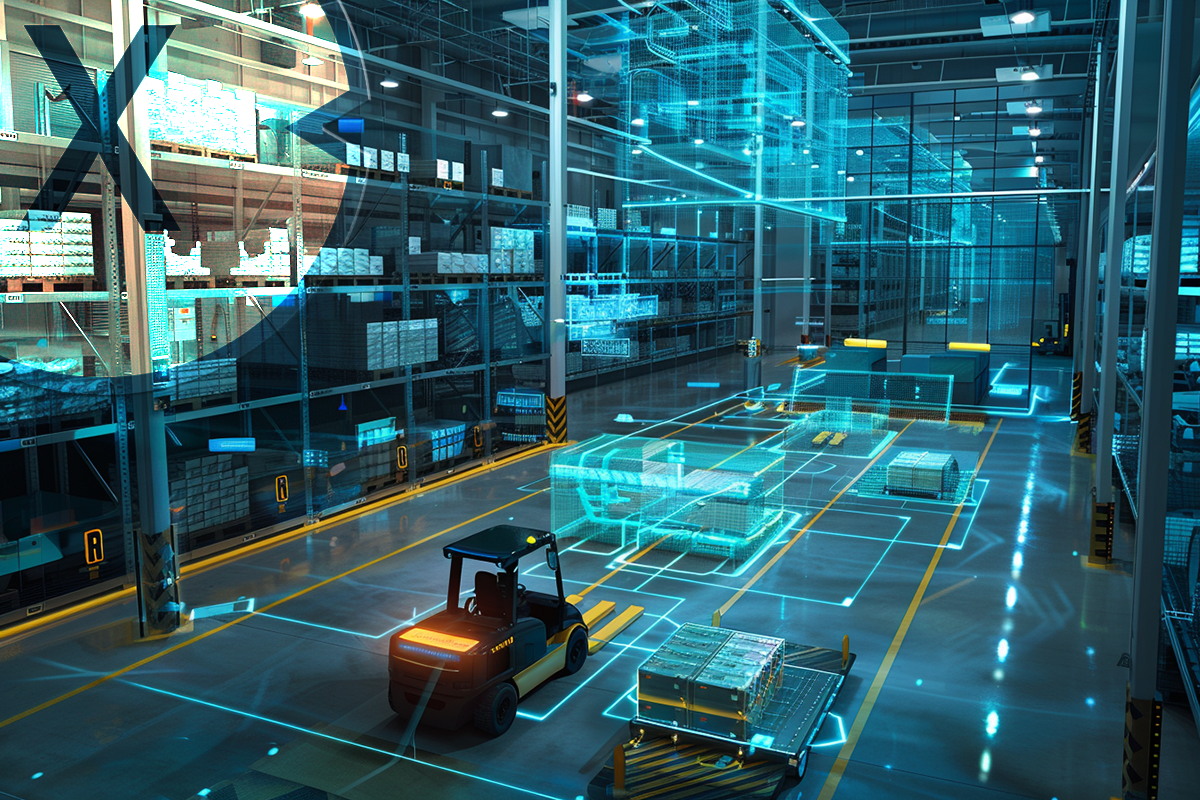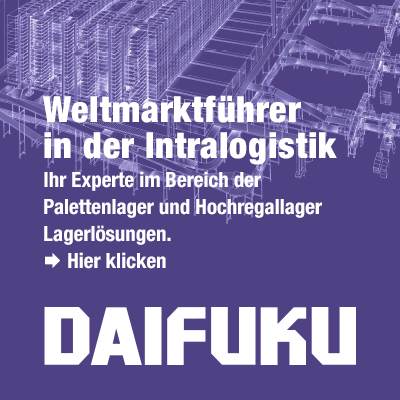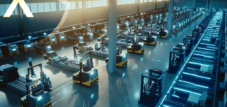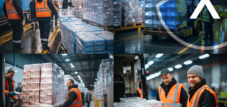Efficient intralogistics: automation for small and medium-sized companies (SMEs)
Language selection 📢
Published on: November 10, 2024 / update from: November 10, 2024 - Author: Konrad Wolfenstein
📦 Competitive advantage through optimized intralogistics for medium-sized companies
📦🔄 Intralogistics forms the backbone of every company
Intralogistics includes all internal material and information flows – from goods receipt through production to shipping. For small and medium-sized companies (SMEs), the efficient design of these processes is crucial in order to remain competitive and meet the increasing demands of the market.
📊 The importance of intralogistics for SMEs
In a globalized economy, SMEs face the challenge of keeping pace with larger competitors. Customers expect short delivery times, high product availability and tailor-made solutions. Inefficiencies in intralogistics can lead to delays, increased costs and customer dissatisfaction. It is therefore essential to constantly optimize internal processes and adapt them to current requirements.
🧩 Challenges in the intralogistics of SMEs
Compared to large companies, SMEs often have limited resources and have to make do with smaller budgets. You face specific challenges:
Limited space
Many SMEs operate in existing buildings with limited storage space. Efficient use of the available space is therefore crucial.
Variable order volume
Fluctuating demand requires flexible systems that can efficiently handle both peak times and quieter periods.
Shortage of staff
The shortage of skilled workers is also affecting the logistics industry. Automation can help bridge bottlenecks and reduce reliance on manual activities.
🚀 Automation as the key to increasing efficiency
Automation offers numerous opportunities to improve intralogistics. Modern technologies make it possible to accelerate processes, reduce errors and reduce costs. For SMEs, this means that, despite limited resources, they can benefit from the advantages that were once only available to large companies.
🔧 Intralogistics automation technologies
1. Warehouse Management Systems (WMS)
A WMS helps manage inventory, optimizes storage space and improves product traceability. Real-time information allows companies to react more quickly to changes and make inventory management more efficient. WMS also enable integration with other systems such as ERP (Enterprise Resource Planning), which leads to holistic process optimization.
2. Automated conveyor technology
Conveyor belts, sorting systems and automatic storage systems accelerate the flow of materials within the company. For example, automatic high-bay warehouses can make optimal use of the available storage space while speeding up access to goods. This not only reduces the space required, but also the time for storage and retrieval.
3. Autonomous Mobile Robots (AMR)
These robots can transport goods independently and help avoid bottlenecks in the flow of materials. They can be used flexibly and can be easily integrated into existing systems. In contrast to permanently installed conveyor systems, AMR can be quickly adapted to changing processes.
4. Pick-by-Light and Pick-by-Voice systems
These technologies support employees in picking. With pick-by-light, light displays at the storage locations show which items should be picked. Pick-by-Voice uses voice control so that employees have both hands free. Both systems reduce error rates and increase the speed of order processing.
5. Robotics and cobots
Robotic arms and collaborative robots (cobots) can take on repetitive tasks, such as packing or palletizing goods. Cobots work side by side with human employees and can be used flexibly for various tasks.
💡 Benefits of automation for SMEs
Cost reduction
Through more efficient processes and fewer errors, companies can reduce their operating costs. Investments in automation often pay for themselves quickly through the savings achieved. In addition, personnel costs can be reduced or employees can be used for more value-adding activities.
increase of productivity
Automated systems work faster and more precisely than manual processes. This leads to higher throughput and enables more orders to be processed in less time. This allows companies to remain competitive, especially in times of high demand.
Improving quality
Mistakes when picking or transporting goods can be costly and affect customer trust. Automation reduces these errors and increases customer satisfaction through reliable and on-time deliveries.
Flexibility and scalability
Automated solutions can be adapted to changing requirements. As order volumes increase, systems can be expanded without the need for extensive restructuring. Technologies such as AMR or modular storage solutions make it possible to react quickly to market changes.
🛠️ Implementation challenges
Despite the many benefits, there are also challenges that SMEs need to consider when adopting automation technologies:
Investment costs
The purchase of automated systems initially requires a financial investment. Companies need to carefully consider which solutions will deliver the most value and how they can be financed. Funding or leasing models can help reduce initial investments.
Integration into existing processes
New technologies must be seamlessly integrated into existing processes. This may require technical adjustments and careful planning. It is important to work with experienced partners who understand the specific needs of SMEs.
Training of employees
The introduction of new systems often means that employees have to be retrained. It is important to involve them early on and show them the benefits of the changes. A positive attitude from the workforce makes implementation much easier.
Technological complexity
The variety of technologies available can be overwhelming. A clear strategy and advice from experts help you make the right decisions and make optimal use of the systems.
🔮 Further developments and trends
Intralogistics is facing a digital revolution. Technologies such as artificial intelligence (AI), Internet of Things (IoT) and big data analytics will play an even greater role in the future. This opens up further opportunities for SMEs:
Predictive Analytics
By analyzing data, companies can create forecasts and proactively optimize their processes. For example, maintenance intervals for machines can be planned based on usage data to avoid failures.
Networked systems
IoT enables communication between different devices and systems. Sensors can provide real-time data about inventory, temperature or location of goods. This leads to even more efficient control of material flows and increases transparency in the supply chain.
Artificial intelligence
AI can make complex decisions and control processes autonomously. In intralogistics, AI can be used, for example, in AMR route optimization, inventory forecasting or automatic quality control.
Virtual and augmented reality
These technologies can be used in employee training or maintenance work. They enable interactive and practical training environments.
📈 Practical example: Successful automation in an SME
A medium-sized trading company was faced with the challenge of dealing with increasing order volumes with limited staff. By introducing a warehouse management system and using pick-by-voice technology, picking performance was increased by 30%. The error rate fell by 50% and employee satisfaction increased due to the easier way of working.
🏆 Reduce costs and increase competitiveness
The automation of intralogistics offers small and medium-sized companies enormous potential. By using modern technologies, you can optimize your processes, reduce costs and increase your competitiveness. Despite the initial challenges, the investment in the future is worthwhile. With the right strategy and experienced partners at their side, SMEs can successfully take the step into automated intralogistics and benefit from the numerous advantages.
Digitalization and automation are no longer just trends, but rather decisive factors for long-term success. Companies that seize these opportunities position themselves for the requirements of the future and can react flexibly to market changes.
📣 Similar topics
- 🚛 Intralogistics as the backbone of the company
- 🏭 Challenges and solutions for SMEs in intralogistics
- 📦 Automation technologies: The future of intralogistics
- 🤖 Robotics and cobots: increasing efficiency in small companies
- 🔍 WMS and ERP: Optimization through integration
- 📊 Big Data and AI: The revolution in intralogistics
- 🌐 Networked systems: IoT and intralogistics
- 📈 Automation as the key to competitiveness
- 🛠️ Challenges in implementing new technologies
- 🎯 Practical example: Successful automation in intralogistics
#️⃣ Hashtags: #Logistics #Automation #SME #Efficiency #Technology
Xpert partner in warehouse planning and construction
🌟 In detail: Automation for medium-sized businesses – More than just a trend
📦 Intralogistics, i.e. all material flows and goods movements within a company, is the heart of every manufacturing or trading company. Especially for small and medium-sized companies (SMEs), efficient intralogistics represents a crucial lever for competitiveness and growth. For a long time, automation solutions were considered the domain of large corporations. However, advancing technological development, falling costs and the increasing shortage of skilled workers are making automation more and more attractive and affordable for SMEs. It's no longer just about transport from A to B, but about the intelligent networking of all processes in order to save time and resources and increase productivity.
🎯 The challenges of intralogistics in medium-sized companies
SMEs often face specific challenges in intralogistics. In the past it was all about keeping costs down, but today flexibility and adaptability to fluctuating market conditions are required. Smaller companies often have limited storage space and need to quickly adapt their processes to new product variants or seasonal peaks. The increasing online trade and the associated requirements for fast delivery times and high delivery accuracy are increasing the pressure. Added to this is the ever-present shortage of skilled workers, which makes it difficult to find qualified personnel for warehouses and logistics. All of these factors make optimization of intralogistics processes essential.
🤖 Automation: From simple solutions to complex systems
The range of automation solutions for intralogistics is wide and ranges from simple tools to complex, fully automated systems. It is important for SMEs to find the right solution for their individual needs. Not all automation has to be expensive and complex. Small adjustments are often enough to achieve significant improvements.
🚚 Examples of automation solutions in medium-sized businesses
- Automated guided vehicles (AGVs) transport goods autonomously through the warehouse or production hall. They navigate using markers, sensors or GPS and can be flexibly adapted to changing environments. AGVs relieve employees of monotonous transport tasks and reduce the risk of accidents.
- Automatic storage and picking systems: These systems range from simple storage and retrieval machines to complex shuttle systems. They enable efficient storage and picking of goods and optimize the use of storage space.
- Robot-assisted palletizing and depalletizing: Robots can automatically palletize and depalletize heavy and bulky goods. This relieves employees of physical strain and increases the speed and accuracy of the processes.
- Pick-by-voice and pick-by-light: These systems support employees when picking goods. Pick-by-Voice gives instructions via voice command, Pick-by-Light guides the employee to the right storage location using optical signals. Both systems reduce sources of error and increase picking performance.
- Warehouse Management Systems (WMS): A WMS controls and optimizes all warehouse processes, from receiving goods to shipping. It provides a comprehensive overview of inventory and enables efficient storage space management.
🚀 Benefits of automation for SMEs
- Increase in efficiency and productivity: Automated processes run faster and more precisely than manual activities.
- Reduction of sources of error: Automation minimizes human errors and improves the quality of processes.
- Relief for employees: Employees are freed from monotonous and physically demanding tasks and can concentrate on value-adding activities.
- Improved occupational safety: Automated systems reduce the risk of accidents in the warehouse and in production.
- Optimization of storage capacity: Automated storage systems enable space-saving storage and maximize the use of the available space.
- Flexibility and scalability: Automation solutions can be flexibly adapted to changing requirements and expanded if necessary.
- Competitive advantages: Efficient intralogistics enables faster delivery times and higher delivery accuracy, which increases customer satisfaction and creates competitive advantages.
🌐 The right strategy for automation
The introduction of automation solutions should be well planned and approached strategically. It is important to analyze the individual needs of the company and select the appropriate solution. Gradual automation, starting with individual processes, can make sense to minimize investment costs and get employees used to the new technologies. Involving employees in the automation process is crucial for success. Training and further education measures help employees to understand and use the new technologies. Open communication and transparent information about the goals and benefits of automation promote acceptance and motivation among employees.
The automation of intralogistics is no longer a luxury for SMEs, but a necessity in order to survive in the competition. Through the right strategy and selection of the right solutions, SMEs can optimize their processes, reduce costs and sustainably strengthen their competitiveness. The future of intralogistics lies in the intelligent networking of people and machines in order to optimally exploit the potential of automation.
📣 Similar topics
- 🤖 Intralogistics in transition: automation for SMEs
- 🚀 Efficient processes: The key to success in medium-sized businesses
- 🏭 Automation solutions: From small tools to large systems
- 📈 Growth through technology: How SMEs can benefit
- 🔄 Flexibility in intralogistics: SMEs master challenges
- 🤖 Man meets machine: The future of intralogistics for SMEs
- 🛠️ Individual solutions: Tailor-made automation for SMEs
- 🌐 Networked processes: The future of intralogistics in medium-sized businesses
- 👷 Avoiding the shortage of skilled workers: Automation as a solution
- 💡 Step-by-step success: automation strategy for SMEs
#️⃣ Hashtags: #Automation #SME #Intralogistics #Efficiency #Technology
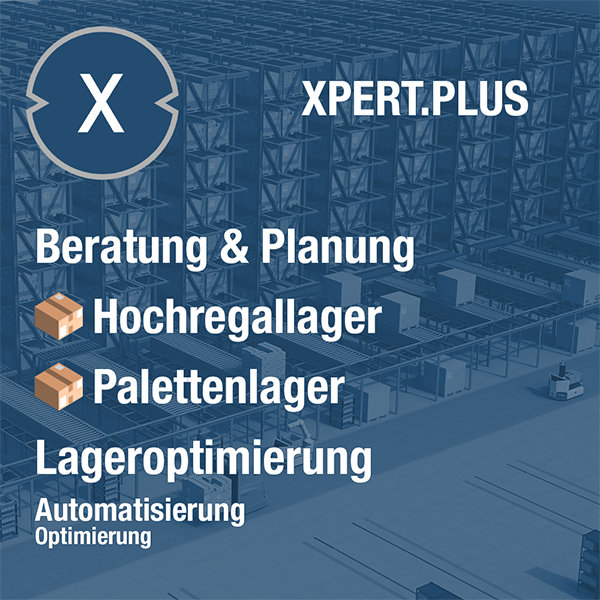
Xpert.Plus warehouse optimization - high-bay warehouses such as pallet warehouses consulting and planning
We are there for you - advice - planning - implementation - project management
☑️ SME support in strategy, consulting, planning and implementation
☑️ Creation or realignment of the digital strategy and digitalization
☑️ Expansion and optimization of international sales processes
☑️ Global & Digital B2B trading platforms
☑️ Pioneer Business Development
I would be happy to serve as your personal advisor.
You can contact me by filling out the contact form below or simply call me on +49 89 89 674 804 (Munich) .
I'm looking forward to our joint project.
Xpert.Digital - Konrad Wolfenstein
Xpert.Digital is a hub for industry with a focus on digitalization, mechanical engineering, logistics/intralogistics and photovoltaics.
With our 360° business development solution, we support well-known companies from new business to after sales.
Market intelligence, smarketing, marketing automation, content development, PR, mail campaigns, personalized social media and lead nurturing are part of our digital tools.
You can find out more at: www.xpert.digital - www.xpert.solar - www.xpert.plus



